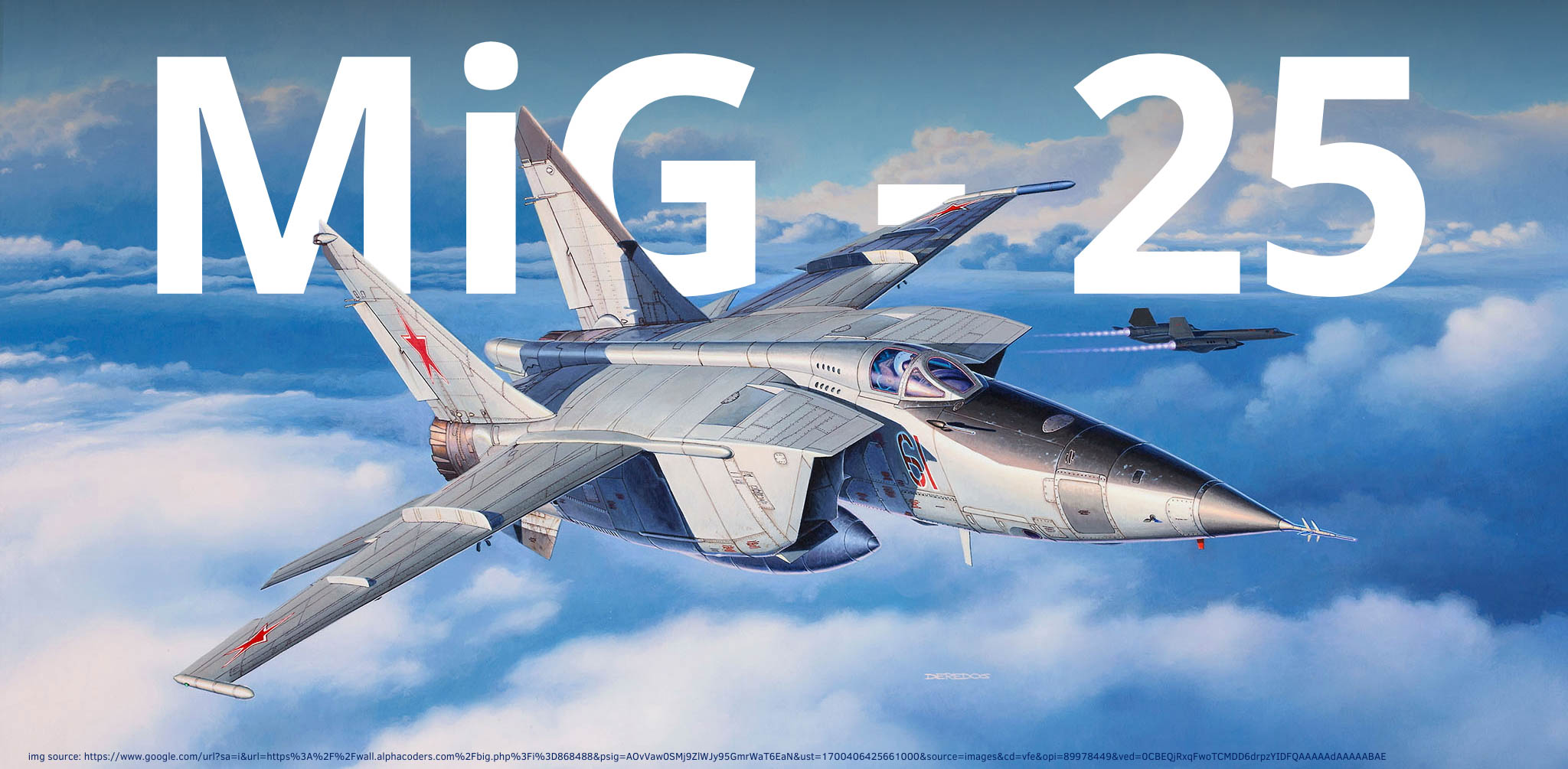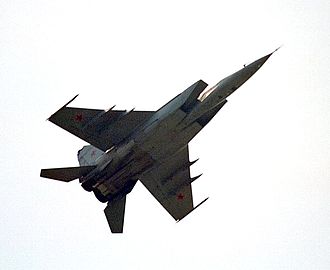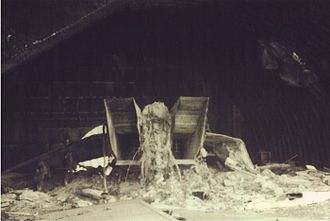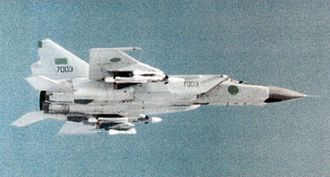


The unarmed 'B' version had greater impact than the interceptor when the USSR sent two MiG-25R and two MiG-25RB to Egypt in March 1971, which stayed until July 1972. They were operated by the Soviet 63rd Independent Air Detachment (Det 63), which was established for this mission. Det 63 flew over Israeli-held territory in Sinai on reconnaissance missions roughly 20 times. The flights were in pairs at maximum speed and high altitude, between 17,000 and 23,000 m (56,000 and 75,000 ft). On 6 November 1971, a Soviet MiG-25 operating out of Egypt flying at Mach 2.5 was met by Israeli F-4Es and fired upon unsuccessfully. A MiG-25 was tracked flying over Sinai at Mach 3.2 during this period. The MiG-25 engines went into overspeed, which led to them being scrapped. Det 63 was sent back home in 1972. Soviet-operated reconnaissance Foxbats returned to Egypt in 19–20 October 1973, during the Yom Kippur War. Det 154 remained in Egypt until late 1974.
During the 1970s, the Soviet air force conducted reconnaissance overflights across Iran using its MiG-25RBSh aircraft in response to joint US-Iran recon operations.
The Swedish Air Force observed Soviet Air Defence MiG-25s via radar regularly performing intercepts at 19,000 m (62,000 ft) and 2.9 km (1.8 mi) behind the Lockheed SR-71 Blackbird at 22,000 m (72,000 ft) over the Baltic Sea in the 1980s.
On 13 February 1981, the Israeli Air Force sent two RF-4Es over Lebanon as decoys for Syrian MiG-25 interceptors. As the MiGs scrambled, the RF-4Es turned back delivering chaff and using ECM pods. Two IDF/AF F-15As were waiting for the MiGs and shot one of them down with AIM-7F Sparrow missiles. The other MiG was able to escape. In a similar engagement, on 29 July 1981, a Syrian MiG-25 was again downed by an Israeli F-15A, after which a second MiG-25 launched its R-40 missiles at the F-15 and its wingman, but they missed.
The first reported activity of Syrian MiG-25 aircraft in the civil war was on 8 February 2014, when two Turkish Air Force F-16s were scrambled to intercept a Syrian MiG-25 which was approaching the Turkish border.

All confirmed air-to-air kills by the MiG-25 were made by Iraq.
The MiG-25 was in service with the Iraqi Air Force during the Iran–Iraq War. Iraqi claimed their MiG-25s shot down at least 15 Iranian aircraft during the war, while only one MiG-25 was lost in air combat (one more lost by SAM)
The most successful Iraqi MiG-25 pilot of the war was Colonel Mohommed Rayyan, who was credited with ten kills. Eight of these were while flying the MiG-25PD from 1981 to 1986. In 1986, after attaining the rank of Colonel, Rayyan was shot down and killed by Iranian F-14s. For the majority of the air combat Iraqi pilots used R-40 missiles.
According to research by journalist Tom Cooper, Iranian claimed ten MiG-25s (nine reconnaissance and one fighter) may have been shot down by Iranian F-14s (one of them shared with an F-5) during the Iran-Iraq war. Only three MiG-25 losses (to ground fire or air combat) were confirmed by Iraq.
Confirmed MiG-25 combat losses during Iran-Iraq war:
The MiG-25 was also used as a strike aircraft during the war, targeting Iranian cities.

During the Persian Gulf War, a U.S. Navy F/A-18, piloted by Lt Cdr Scott Speicher, was shot down on the first night of the war[when?] by a missile fired by a MiG-25. The kill was reportedly made with a Bisnovat R-40TD missile fired from a MiG-25PDS flown by Lt. Zuhair Dawood of the 84th squadron of the IQAF,
Two IQAF MiG-25s were shot down by U.S. Air Force F-15s on 19 January. The MiGs attempted to hide from the F-15s by using chaff and electronic jammers in order to engage the F-15s untargeted. However the F-15 pilots were able to reacquire the two Iraqi MiG-25s and shot both down with AIM-7 Sparrow missiles. In another incident, an Iraqi MiG-25PD, after eluding eight USAF F-15s at long range, fired three missiles at General Dynamics EF-111A Raven electronic warfare aircraft, forcing them to abort their mission and leave attacking aircraft without electronic jamming support.
In a different incident, two MiG-25s approached a pair of F-15s, fired missiles at long range which were evaded by the F-15s, and then outran the American fighters. Two more F-15s joined the pursuit, and a total of 10 air-to-air missiles were fired at the MiG-25s, though none reached them.
On 30 January 1991, an IQAF MiG-25 damaged a USAF F-15C by a R-40 missile in the Samurra Air Battle. Iraq claims it was shot down and fell in Saudi Arabia.
After the war, on 27 December 1992, a U.S. F-16D downed an IQAF MiG-25 that violated the no-fly zone in southern Iraq with an AIM-120 AMRAAM missile. It was the first USAF F-16 air-to-air victory and the first AMRAAM kill.
On 23 December 2002, an Iraqi MiG-25 shot down a U.S. Air Force unmanned MQ-1 Predator drone, which was performing armed reconnaissance over Iraq. This was the first time in history that an aircraft and an unmanned drone had engaged in combat. Predators had been armed with AIM-92 Stinger air-to-air missiles and were being used to "bait" Iraqi fighter aircraft, then run. In this incident, the Predator did not run, but instead fired one of the Stingers, which missed, while the MiG's missile did not.
No Iraqi aircraft were deployed in the U.S. invasion of Iraq in 2003, with most Iraqi aircraft being hidden or destroyed on the ground. In August 2003, several dozen Iraqi aircraft were discovered buried in the sand.

The MiG-25 was kept a guarded secret in India, designated Garuda after the large mythical bird of Vishnu from Hindu scriptures. It was used extensively in the Kargil War and Operation Parakram, conducting aerial reconnaissance sorties over Pakistan.
In May 1997, an Indian Air Force Mikoyan MiG-25RB reconnaissance aircraft created a furor when the pilot flew faster than Mach 3 over Pakistani territory following a reconnaissance mission into Pakistan airspace. The MiG-25 broke the sound barrier while flying at an altitude of around 20,000 m (66,000 ft), otherwise the mission would have remained covert, at least to the general public. The Pakistani Government contended that the breaking of the sound barrier was a deliberate attempt to make the point that the Pakistan Air Force (PAF) had no aircraft in its inventory that could come close to the MiG-25's cruising altitude (up to 23,000 metres (74,000 ft)). India denied the incident but Pakistan's Foreign Minister, Gohar Ayub Khan, believed that the Foxbat photographed strategic installations near the capital, Islamabad.
Lack of spare parts and India's acquisition of unmanned aerial vehicles and satellite imagery eventually led to its retirement in 2006.
Subsequently, six out of the seven surviving MiG-25s (the eighth aircraft was lost in a crash in 1994) have been preserved at various locations in India.
An aerial observation of the solar eclipse of 24 October 1995 over India was conducted by a MiG-25, which took images of the eclipse at an altitude of 25,000 m (82,000 ft).

Libya was a major user of the MiG-25 as it imported 96 MiG-25PD interceptor, MiG-25PU trainer and MiG-25RBK reconnaissance aircraft in the late 1970s and early 1980s.
During the 1980s, Libya confronted the United States over some claims over the extension of its territorial waters. These incidents prompted a number of encounters between the opposing forces as it happened during the Gulf of Sidra incident (1981) with the Libyan MiG-25s taking part in them.
During the following years, the Libyan MiG-25 fleet was grounded, lacking maintenance. As MiG-25s had been grounded for several years, NATO attacks spared them during the Libyan Civil War (2011).
In 2014 and 2015, the Libyan forces under the New General National Congress controlled a number of former LARAF airframes, that were retired and stored before the Libyan Civil War in 2011, among them a number of MiG-25s. Technicians started working on some of the airframes to press them back to service in the fight against the opposing internationally recognized Libyan government forces.
On 6 May 2015, a New General National Congress MiG-25PU crashed near Zintan while attacking the civilian airport controlled by the opposing internationally recognized Libyan government, the pilot ejected and was captured by opposing forces which also claimed they downed the jet. The jet may have been on one of its first flights after re-entering service.